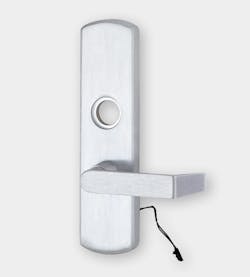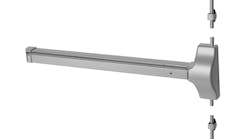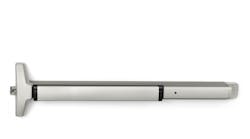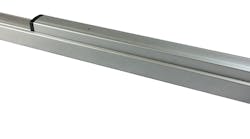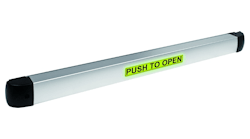When it comes to door hardware and the security industry, it’s possible that no other piece of equipment has as much asked of it as the exit device.
First and foremost, of course, the exit device has to provide safety and security. But it also has to be used in certain applications and on certain doors, particularly when the occupancy of a room is a major consideration. It has to be configured in a way to comply with fire regulations (no mechanical dogging, for example). It has to take the Americans with Disabilities Act into consideration. It has to be aesthetically pleasing, or as pleasing as a roughly yard-wide hunk of steel can be. Finally, it must be able to be tied into the ever-expanding world of access control and monitoring.
Motoring Ahead
The final demand means electrification, and the name of the game these days when it comes to the electrification of exit devices is motorized latch retraction (MLR), although some manufacturers might use slightly different terminology. MLR means that a small motor drives the retraction of the latch rather than a solenoid. This provides two big benefits to the end user:
- MLR is quieter, which is particularly notable in certain applications, such as hospitals.
- MLR draws less power.
Solenoid-driven electric exit devices can draw as much as 16 amps. MLR uses in the neighborhood of 1–1.5 amps. Besides the obvious energy savings, this distinction produces an additional benefit, according to Michael McCoy, product manager, exits and closers with Stanley Security Solutions, a division of dormakaba.
“When you don’t require as much current, you don’t need to necessarily place the power source so close to the opening,” he points out. “It has enabled customers to put their power supplies in a more consolidated storage, like electrical closets, farther away from the openings.”
Plus, if the exit device draws less current, a smaller, less expensive power supply can be used, or more devices can be connected to the same power supply. (Of course, you always should make sure that any power supply has the capacity to handle all connected devices.)
Because of those benefits, manufacturers are moving steadily toward MLR electrification as an option on their exit devices and exit device electrification kits. At least one expert whom we interviewed predicts that solenoid-driven electrification will disappear, although no one seems to believe that will happen soon.
Solenoid electrification has one clear benefit, which is retraction time, says Sylvons Iyavoo, senior product manager of Adams Rite, a division of ASSA ABLOY. He notes that from the time you, say, swipe a card through a reader to the time the exit device unlatches is 0.8 seconds when the exit device has MLR. It’s instantaneous with a solenoid. This could be an important distinction in a high-traffic area.
“Some customers, the moment they show the access card, they just push the door open,” he says. “They don’t wait.” This can be a problem because it puts unnecessary “preload” on the electrical system, which can lead to poor performance, and, ultimately, replacement.
Other benefits could include cost in a large application where the voltage is known and constant and, even, the sound in certain situations, McCoy says.
“They actually want to hear that solenoid fire,” he says. “They want to hear the activation of the solenoid with some sort of audio acknowledgement that the latches have retracted.”
Having the Right Touch
Another demand for the exit device is that it must satisfy people’s newfound desire to not touch anything.
Of course, the push-bar exit device can be a great piece of hardware with respect to creating “hands-free” egress, because the bar can be bumped and unlatched by using your hip or back, rather than be pushed by a hand.
Electrification is a more refined way of accomplishing the same task. Electrification means the exit device can be connected not only to a reader that can check credentials, but also to a door operator and touchless actuator, so you don’t have to come in contact with the door at all.
“It’s completely automated,” Iyavoo says. “You flash the card. It gives you access, and the door automatically opens for you, and you exit — completely touch-free.”
Retrofitting such a solution is “one of the simplest things you can do,” says Kerby Lecka, director of marketing at SDC–Security Door Controls. He notes that SDC and other companies have come up with and actively market such combined solutions.
The downside to such a unified means of touchless entrance and exit is cost. Obviously, the more you do to the door, the higher the cost of the installation will be, and some customers have only so much to spend. With that in mind, and the acceptance that at least some touching of the exit device likely will be necessary, manufacturers are turning to adding protective coatings as options to their door hardware, including exit devices.
The most common is a silver-ion-based antimicrobial coating, which typically is produced by a partnership with a third-party provider and carries a trademarked name. For example, dormakaba products use UltraShield, and exit devices or other dormakaba-branded products that include that option have UltraShield laser-etched onto the product as “confirmation,” McCoy says.
Allegion is one of those companies, but Allegion also has a new option available for the push pads of its Von Duprin line of exit devices, among other products. This option includes copper.
The U.S. Environmental Protection Agency acknowledges 350 copper alloys that are listed by ASTM International as antimicrobial. This is based on independent testing that shows that regularly cleaned copper alloys kill more than 99.9 percent of certain bacteria within 2 hours of exposure at room temperature, including MRSA and the bacteria that cause staph infections.
Although studies haven’t shown conclusively that copper has antiviral properties, it’s reasonable to assume that more manufacturers will look into copper as another way to help customers assuage users’ fears about touching door hardware, including exit devices.
Now or Later
Two more things about electrification: Typically, it’s an option for otherwise manually operated exit devices, and it’s better to do it upfront if possible.
“I’ve been in the industry for a fair amount of time, and as a result, I’ve learned over the years that it’s typically far better, far easier and far less expensive to outfit the opening with the electrification as you’re doing the new install,” McCoy says, noting that dormakaba sells factory-installed electric exit devices and retrofit electrified latch retraction (ELR) kits.
Of course, wiring after the fact can be more of a hassle, and, during the retrofit process, you have to be careful with installing the kit and making sure that the door is aligned and the exit device is reassembled properly. An error could lead to diminished performance and even compromise the security of the door.
That said, retrofit ELR kits are certainly a viable option, says Jon Dilley, product leader, Exits Category with Allegion, which makes the Von Duprin and Falcon lines of exit devices.
“One of the things that we focus on continually is having retrofit kits, so that exit device can change over time,” he says. This is because the demands on a particular exit and, thus, any exit device there might change over time. The customer might want to add MLR, for example, or request to exit or delayed egress — common options that can be added after the fact.
It’s also acceptance of simple logistics, Lecka adds. “There are thousands upon thousands upon thousands of doors that have mechanical exit devices.” He adds that customers who want to add access control to the door don’t necessarily want to replace the exit device altogether, so retrofit kits allow them to “keep that bar.”
It’s important to make sure that any retrofit kit carries the same Underwriters Laboratory (UL) rating that the exit device has, so the exit device remains within code. Most retrofit kits go through the same UL testing process that the original equipment does. For example, if the kit carries the proper UL listing for fire ratings, the door will remain compliant.
Speaking of “later,” with respect to what might be ahead for exit devices aside from more MLR, one possibility is an increase in wireless connectivity, Iyavoo says, noting how much time and money typically is involved in wiring or rewiring electronic access control devices in general.
“You need to install the right gauge wires and so many things,” he says. “You need to add a conduit; you need to do so many things on the door; you need to drill a hole into the door. It's a big process.” Wireless, of course, cuts that process down considerably.
It’s just another way to make sure that the venerable exit device continues to keep up with demand and expectations.
Following are a few options for exit device installation and retrofit.
Von Duprin M996L/L-BE
The new M996 electrified exit trim from Allegion brand Von Duprin adds motor-driven capability in place of a solenoid. (The E996 version is slated for eventual retirement, Dilley says.)
This accomplishes two things beyond drawing less power, says Daniel Cannon, Allegion product manager, door controls. One is that the exit trim will run on either 12- or 24-volt power. The other is that the exit trim now has easy field-selectable fail-safe or fail-secure operation through the inclusion of a dip switch.
“In our old product, you actually had to take the device mechanically apart to switch from one function to the other,” Cannon says. “So it’s a little bit more flexible and easier to install.”
The M996 comes either with key bypass (L) or just a blank escutcheon (L-BE). The trim can be ordered with an exit device, added to a Von Duprin 98/99 series exit device or come as a conversion kit for existing mechanical (996) or electrical (E996) trim.
Features:
- Breakaway lever engages when more than 35 lbs. of torque pressure is applied to a locked lever
- Field-reversible handing
- Maximum inrush amperage: 1.12 (12V), 0.6 (24V)
More info: https://us.allegion.com
Command Access MLRK1-COR, MLRK1-MRK-DH
Command Access continues to revamp and roll out updates to its retrofit ELR kits that include MLR as the central feature. The latest to get the treatment are for the Corbin Russwin ED4000/ED5000 or Yale 7000 series exit devices and Marks USA M9900 or Design Hardware 1000 series exit devices.
According to Mateo Kristoff, director of sales and marketing at Command Access, the updates accomplish two things. First, they minimize friction so the motor can deliver more pulling power. Second, and more important to installers, they improve the ease with which the kit can be installed.
For example, with the Corbin Russwin/Yale models, the method of attaching the motor mount to the device had been to use an aluminum block that had a set screw in it that would hook on to the back activating bracket. By using an Allen key, you secured the aluminum block to the activating bracket and then screwed the motor into that. The new kit has no aluminum block.
“There’s no need for a set screw or an Allen key to tighten anything down,” Kristoff says. “Now, it really just drops over the dogging tailpiece [of the exit device]. You put two screws in the existing holes to secure the motor mount, and you’re good to go.”
Although the product is different, Kristoff says Command Access made similar improvements to the Marks kit, so installers no longer have to disassemble the push pad on the exit device.
Features:
- UL listed
- Optional REX built-in
- Full electronic dogging
More info: www.commandaccess.com
Precision Hardware Apex 2110VI
The 2110VI is the latest model option in dormakaba brand Precision Hardware’s long-running Apex 2000 series of exit devices, and it comes with a unique feature — a visual indicator.
The visual indicator (the VI part of the product name) is aimed at lockdown situations in schools and is meant to accomplish two things: to direct the person inside which way to rotate the key or thumbturn to lock the door and to provide visual confirmation that the door is locked. It was developed in response to requests from school districts, McCoy says.
“What those end users wanted was the ability to quickly lock the outside lever of that door so they didn’t have to open the door and check the lock, drawing attention to the room,” he says. “That’s essentially what we’ve created.”
The lock requires only a quarter-turn (90 degrees) to lock and unlock, with the visual indicator showing as red for locked and green for unlocked.
McCoy says the feature, which is also available as a retrofit kit for certain Apex models, is something that the company is looking to expand to other lines in dormakaba’s lineup, including the Dorma 9000 series, but it couldn’t provide a timeline for when that might happen.
Features:
- Grade 1 exit device, fire or panic
- All types of doors, 1-3/4 in. to 2-1/4 in. thick
- 4900 Series exit trim
- 11 product finishes, including UltraShield antimicrobial coating
More info: www.precisionhardware.com
SDC S4000E Spectra Series
New S4000E Spectra Series exit devices include a notable feature — MLR is built in as standard.
“We decided to make it real easy for the installer,” Lecka says, adding that SDC already makes MLR optional on its other exit devices and in its retrofit kits.
But Lecka says the S4000E Spectra series, which includes rim and vertical rod models, has more than just low-power output in mind. It has a low-profile bar height of less than 2 inches, and the push pad is scratch- and finger-resistant.
Also, the exit device has stainless steel construction, which makes it particularly resistant to the elements.
“Think about the warehouse-like back door,” Lecka says. “It’s a big steel door facing the parking lot. When the door is open, the exit device is exposed to moisture even though it’s on the inside of the door, so to extend the longevity, we made the whole thing stainless steel.”
Features:
- Grade 1 exit device, fire or panic
- Hollow metal, wood and mineral-core doors, 1-3/4-in. thick
- REX optional
More info: www.sdcsecurity.com
Adams Rite MLR option for Series 8000/3000 exit devices
The MLR option replaces Adams Rite’s now-retired SE version and is available for all 8000/3000 Series exit devices, including the brand’s new P8800/P8700 Pullman latch rim exit devices.
In addition to an improvement in performance stability, Iyavoo says the new option adds a couple of features that are useful to the installer service pro. The first is a series of three audible chirps that identifies bar binding when the latch doesn’t retract while the end user operates the exit device.
“The customer knows that there’s some problem with the way the door is aligned or the device is installed,” he says. “It’s not a device issue; it’s more of a binding issue.” This can help identify the problem or at least eliminate one consideration if service were required.
The second feature is that Adams Rite now includes latch precalibration for the gap between the door and the frame. This means that if the condition of the door and frame are adequate, the exit device will calibrate automatically, and three audible chirps will signal confirmation of that. If the door is in poor condition, then the device must be calibrated manually, which is optional. Previously, Iyavoo says, the installer had to calibrate the exit device manually for each installation.
Features:
- Available for 30-in. to 48-in. doors
- Fail-secure
- Maximum inrush amperage: 0.9 at 24V, requires 2-amp power supply
- REX compatible
More info: www.adamsrite.com
Yale 7000 Series
So what’s new with the venerable 7000 Series of exit devices from ASSA ABLOY division Yale? What else: MLR.
Actually, Yale calls it MELR for motorized electric latch retraction, but it’s the same thing — a replacement of solenoid-based electrification that results in significant power savings (Yale pegs the difference at 86 percent) and quieter operation.
Chris Comeau, product category manager, exit devices, ASSA ABLOY, adds that MELR allows the exit devices to be connected with a standard power supply.
“The solenoids require a pretty specific power supply and a very expensive power supply, too,” he notes. “So it’s an easier installation. It’s also a little bit cheaper at the end of the day for the end user.”
Yale’s MELR comes as an optional upgrade to the 7000 Series or as a retrofit kit. Comeau notes that it’s the same option as on the Corbin Russwin ED5000 and SARGENT 80 exit device series. He adds that he expects MELR to be added as an option to the Yale 6000 series of exit devices in the near future as well.
Features:
- Grade 1 exit device, fire or panic
- All types of doors, 1-3/4 in. thick
- 18 finishes, with optional MicroShield antibacterial coating
- Options: alarm, bar monitoring, delayed egress, electric dogging, latchbolt status monitoring
More info: www.yalecommercial.com
Marks USA M9900 Series
The first thing you might notice about the M9900 Series of rim exit devices is that there’s no electrification option to it. That’s on purpose, says Bill Sporre, senior vice president of sales for Alarm Lock and Marks USA.
“We wanted to leave it to the experts,” he says, noting that Marks has a reputation for solidly built mechanical hardware that includes a lifetime warranty to back it up. “We feel we’re experts in the mechanical side of it and why try to develop our own electronics for it?”
So, Marks instead went in search of a partner “that had a reputation for good electronics,” noting Command Access and SDC’s ELR kits that can be paired with Marks’ exit devices. This brings the M9900 into the touchless access control realm.
A future partner for Marks likely will be sister company Alarm Lock. Alarm Lock sells trim that can be combined with a Marks exit device, and Sporre says the two divisions of NAPCO likely will sell joint products under a single SKU in the near future.
Features:
- Grade 1 exit device, fire or panic
- Heavy gauge extrusion, steel flush end cap
- Stainless steel satin finish
- Option: Cylindrical dogging
More info: https://marksusa.com
